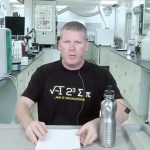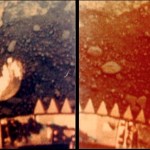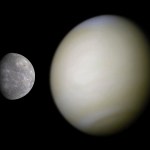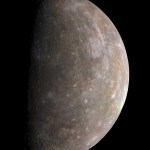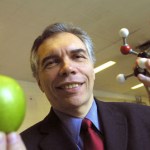Mercury
Way back in the early days of my blogging career, I remember coming across a "challenge" by a man named Jock Doubleday. I didn't know it at the time, but Doubleday had achieved some notoriety before his "vaccine challenge" as the director or Natural Woman, Natural Man, Inc. and the author of such amazing works as The Burning Time (Stories of the Modern-day Persecution of Midwives) and Lolita Shrugged (THE MYTH OF AGE-SPECIFIC MATURITY). His "challenge" was in the same vein as his previous work, only more so and full-on antivaccine. The reason I'm bringing up Doubleday again after all these…
One of the most pernicious lies promoted by the antivaccine movement is a trope that I've labeled the "toxins gambit." Basically, it's the lie, oft repeated in hysterical terms, that there are all sorts of horrible toxic chemicals in vaccines, and it is those toxic substances that are responsible for the claimed adverse effects of vaccines. Now, it is true that there are substances in vaccines that can be toxic, but the toxins gambit completely ignores a little thing known as the dose-response curve or, if you want to go hundreds of years back in time, the admonition attributed to Paracelsus…
It was just over a year ago that I had my last bit to say about a man who can arguably called the antivaccine activist who gave Orac his start. I'm referring, of course, to Robert F. Kennedy, Jr. Indeed, my first deconstruction of the nonsense about vaccines that Kennedy laid down in 2005 in an article foolishly and irresponsibly published in both Salon.com and Rolling Stone was what got Orac noticed, a mere six months or so after this blog had begun—exactly nine years ago, today, amazingly enough. (Holy crap, this blog is old...) Every so often, Kennedy has reappeared to spread fear,…
It's always jarring when I go to a scientific meeting, in this case the American Society of Clinical Oncology (ASCO) meeting, imbibe the latest clinical science on cancer, and then check back to see what the quacks are doing. On the other hand, there was a session at this year's ASCO on "integrative oncology" (stay tuned for an...Insolent...discussion of it sometime in the next few days after I get a chance to watch the videos again and look up the papers cited in support of woo), so maybe it isn't as jarring as it once was to come back into the real world.
Thus I saw in my Google Alerts…
I'm sure that a lot of you, like me, are watching the rebooted version of Cosmos: A Spacetime Odyssey, with Neil deGrasse Tyson taking over the hosting duties originally handled so ably over 30 years ago by Carl Sagan. I definitely enjoyed the first episode and am looking forward to additional episodes. The only thing that annoys me is that Cosmos is on at the same time as The Walking Dead, but that's what DVRs were made for. The first episode, which is all I've seen thus far at this writing, was quite impressive, and the segment at the end in which Neil deGrasse Tyson talks about the time he…
I realize I've been remiss. After all, three or four weeks ago, I pointed out that the week of October 7 to 14, this very week, was going to be Quackery Week. Well, it wasn't actually I who first declared this week quackery week. It was actually our very own U.s. Senate, which, as I pointed out, passed S.Res.221, which declared:
A resolution designating the week of October 7 through October 13, 2013, as “Naturopathic Medicine Week” to recognize the value of naturopathic medicine in providing safe, effective, and affordable health care.
Given that the vast majority of naturopathy is quackery…
One of the major differences between science-based medicine (SBM) and alternative medicine—or, as they call it these days, "complementary and alternative medicine" (CAM) or "integrative medicine"—is that SBM is always questioning itself, always reevaluating its practices. Related to this difference is that SBM does change its practice, discarding treatments that don't work and incorporating those that do work (or at least work better than older practices). As I've said many times before, the process by which this happens is messy and slower than we might like, and that provides ammunition to…
"We make the world we live in and shape our own environment." -Orison Swett Marden
If you had never heard of global warming before, how would you figure out whether it's real or not? And if it is real, how would you figure out what humanity's role in it is? To answer this, I've decided to do a three-part series on how you'd go about figuring this out, putting aside all politics, economics, opinion and any other non-scientific factors. If you missed part 1, you can check it out here; today we're going to build on that and talk about what determines the temperature of a planet with an…
"There is no question that climate change is happening; the only arguable point is what part humans are playing in it." -David Attenborough
It's been a long time since I've written anything on this blog about global warming, climate change, or most Earth-based environmental topics in general. After all, I'm a physicist -- an astrophysicist in particular -- and although I'm well-versed in the physics of the Earth and in science in general, it's not my particular area of expertise.
Image credit: NASA, Johnson Space Center, Apollo 17 crew.
Recently, I've had a number of requests to take a…
Posted to the homepage on August 11, 2013.
The Moon—like the sun, stars and Earth—is easy for a human being to take for granted. But the Earth's moon is truly exceptional, and should be appreciated for shaping the exceptional world we live on. Earth is the only planet with a single moon, and relative to the Earth, Luna is the largest moon in the solar system. The Moon thus exerts a strong, solitary influence on the planet it was torn from. Evidence suggests that the Moon was blown into orbit by a massive asteroid impact about 4.5 billion years ago, shortly before the…
"You don't drown by falling in the water; you drown by staying there." -Edwin Louis Cole
Our Solar System is -- at least from our perspective -- the most well-studied system of planets, moons, asteroids and comets in the entire Universe.
Image credit: Olaf Frohn, from earlier in 2012.
And in this system, the closest planet to our Sun, Mercury, was also one of the most poorly understood planets until very recently. Because Mercury is so close to the Sun, it's very difficult to view it under good conditions with a telescope; the risk of ruining your optics by exposing them to direct…
Well, I'm here. That's right. As I mentioned yesterday, I'm at CSICon. As is the case when I'm at conferences, be they skeptical conferences or professional conferences, it's hard to predict the blogging time available. It could be a lot; it could be a little. Or it could be none. (Well, obviously it's not none, or you wouldn't be reading this.) In any case, there was lots of stuff going on, plus there was the second game of the World Series, which made me miss the live recording of The Skeptics' Guide to the Universe. Oh, well. Steve understood. So I wasn't up for any heavy lifting or taking…
"Don't go around saying the world owes you a living. The world owes you nothing. It was here first." -Mark Twain
So, you've been around a while, seen all sorts of things, and learned an awful lot about the world, solar system and Universe that we live in. But how well do you know it, really?
Image credit: NASA / Lunar and Planetary Laboratory.
To scale and in order, these are the eight planets you know so well. There are the four rocky worlds of our inner solar system: Mercury, Venus, Earth, and Mars, and the four gas giants that dominate the outer solar system: Jupiter, Saturn, Uranus, and…
Yesterday, EPA Administrator Lisa Jackson announced the agency's new Mercury and Air Toxics Standards, which will reduce emissions of heavy metals and acid gases from coal- and oil-fired power plants. The approximately 1,400 units that EPA expects to be affected by the rule (because they aren't already meeting the standard) will have up to four years to come into compliance. An EPA fact sheet explains, "A range of widely available and economically feasible technologies, practices and compliance strategies are available to power plants to meet the emission limits, including wet and dry…
By Joe Schwarcz PhD, Author, USASEF Expo Performer, AT&T Sponsored Nifty Fifty Program Speaker
Physicians today are unlikely to encounter "Gilder's palsy." Nor are they likely to diagnose a patient with "hatter's shakes." But prior to the twentieth century these ailments had to be considered when a patient presented with tremors, irritability, increased salivation and fatigue. In the case of the hatters, the culprit was mercury nitrate used to produce felt. Beaver and rabbit fur, the traditional materials for making felt, can be matted more easily when the pelts are first treated with…
Hair breaks. It singes. It falls out. It might not be the strongest feature of living human bodies, but hair is one of the best-preserved tissues of dead ones, providing a record of diet, age, metabolism, and, sometimes, even the cause of death.
Ferdinand II*
With intense beams of x-rays at Brookhaven's National Synchrotron Light Source (NSLS), a team of researchers is using hair samples collected from the decomposed bodies of two 15th century Italian royalty to determine how they really died.
The subjects: Ferdinand II (1467-1496)* and Isabella (1470-1524) of Aragon, a medieval kingdom…
Over the weekend, I saw a rather fascinating post by Sullivan entitled A Sense of Civil Discourse. The reason I found it so fascinating is because what was quoted in it utterly destroyed my irony meter yet again, leaving it nothing but a molten, gooey mess still bubbling and hissing in my office. Apparently last week, Mark Blaxill and Dan Olmsted, authors of the distillation of all the craziness that is the blog Age of Autism into book form under the same title, The Age of Autism: Mercury, Medicine, and a Man-Made Epidemic, did a radio interview on the Leonard Lopate Show. During the…
THE PAST IS PROLOGUE
Location: Central New Jersey, deep within the brick and steel of a secret pharma base.
Year: 1999.
A shadowy figure dressed in gray, bald, and stroking a white cat enters a nondescript room in the middle of which sits a massive conference table. More than a dozen men and women leap to their feet at attention and wait until the man pauses at the head of the table and then very deliberately sits in high-backed leather chair.
Shadowy figure: Have they arrived?
Lackey #1: Yes, Leader.
Shadowy figure: Let them wait a few minutes. First, we have pressing business. You have…
My Very Excellent Mother Just Served us Nine Pizzas.
My Very Easy Method Just Speeds Up Naming Planets.
My Very Early Morning Jam Sandwiches Usually Nauseate People.
Mon Vieux Tu M'as Jeté Sur Une Nouvelle Planète!
-- Various mnemonic devices for remembering the order of the nine planets
I just found out that Mercury is shrinking.
The planet, already our most diminutive neighbor, has lost around 3 miles of its 3,000 mile diameter in its life, or one tenth of one percent.This may not sound like much, but in geological terms, three miles is immensely significant.
This boggling fact was…
Perhaps you've heard of the case of Poul Thorsen. Perhaps not. Either way, that anti-vaccine movement was making a huge deal over this Danish psychiatrist and researcher for two reasons. First, he has become embroiled in some sort of scandal involving research funds at his former place of employment, Aarhus University, leading the ever-hyperbolic Robert F. Kennedy, Jr. to post a characteristic bit of conspiracy mongering nonsense to that font of anti-vaccine nonsense, The Huffington Post, in an article entitled Central figure in CDC Vaccine Cover-Up Absconds with $2M. The second reason is…

